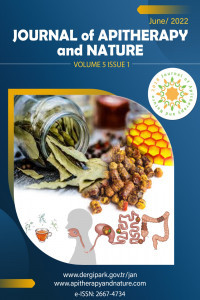Isolated Triterpenes from Stingless Bee Lisotrigona furva Propolis in Vietnam
Isolated Triterpenes from Stingless Bee Lisotrigona furva Propolis in Vietnam
Lisotrigona furva propolis, NMR,
___
- 1. Nguyen, H. X., Nguyen, M. T., Nguyen, N. T., & Awale, S. (2017). Chemical Constituents of Propolis from Vietnamese Trigona minor and Their Antiausterity Activity against the PANC-1 Human Pancreatic Cancer Cell Line. Journal of natural products, 80(8), 2345-2352.
- 2. Sanpa S., Popova M., Bankova V., Tunkasiri T., Eitssayeam S., Chantawannakul P. (2015). Antibacterial compounds from propolis of Tetragonula laeviceps and Tetrigona melanoleuca (Hymenoptera: Apidae) from Thailand. PLoS One, 10(5), e0126886.
- 3. Yoon, N. Y., Min, B. S., Lee, H. K., Park, J. C., & Choi, J. S. (2005). A Potent Anti-complementary acylated sterol glucoside fromOrostachys japonicus. Archives of pharmacal research, 28(8), 892.
- Yayın Aralığı: Yılda 2 Sayı
- Başlangıç: 2018
- Yayıncı: Oktay YILDIZ
Carmen Violeta POPESCU, Hazem ABBAS, Stefan MANEA, Lili IVOPOL, Alina DUNE, Candice POPINIUC, Dumitru LUPULEASA
The Efficacy of Propolis Fluoride in Inhibiting Dental Caries Activity on Primary Teeth
Risqa Rina DARWITA, Iwany AMALLIAH, Sri Angky SOEKANTO, Muhamad SAHLAN
İsamara Julia CAMURI, Adriano Batista COSTA, Wallance Moreira PAZIN, Amando Siuiti ITO
Anticancer Properties of Aqueous and Nonaqueous Propolis Extracts
Zbigniev BALION, Aistė JEKABSONE, Kristina RAMANAUSKIENE, Daiva MAJIENĖ
Direct Visualization of Artepillin C into Fibroblast Cells via CARS Microscopy
Wallance M. PAZIN, Vita SOLOVYEVA, Tibebe LEMMA, Bjarke JØRGENSEN, Carlos José L. CONSTANTINO, Jonathan BREWER
Fatty Acid Analysis and Biological Activity of Jordanian Propolis
Ashok K. SHAKYA, Shankar KATEKHAYE, Ghaleb A. ORIQUAT, Rajashri R. NAIK, Rajashri R. NAIK, Anant PARADKAR, Hugo FEARNLEY, James FEARNLEY
Ahmad SULAEMAN, M MAHANI, HARDINSYAH HARDINSYAH, E DARMA, S. R. MUBAROKAH, N NURJANAH
Cytotoxic Activity of Four Propolis Colombian Samples Against Canine Osteosarcoma Cells
Dolly Patricia Pardo MORA, Oscar Julián MURILLO, Mauricio Rey BUITRAGO, Mónica LOSADA, Jaime Fabian Cruz URIBE, Karina Basso SANTIAGO, Bruno José CONTI, José Maurício SFORCIN
Quantitative and Qualitative Variations in Propolis Collection
C. TANANAKI, A. THRASYVOULOU, D. KANELIS, V. LIOLIOS
Chemical Profiling of Papua New Guinea Propolis and Assay its Antiprotozoal Activity
Samya ALENEZI, Naif Alenezi MANAL, J NATTO, Harry P. De KONING, John IGOLI, David G. WATSON
